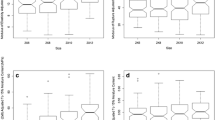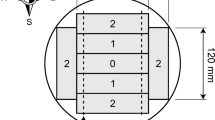Abstract
Loblolly pine is increasingly grown on intensively managed plantation forests that yield excellent growth; however, lumber cut from these trees often contains a large percentage of juvenile wood which negatively impacts strength and stiffness. Because of changing forest management and mill practices the design values for visually graded southern pine were updated in 2013 to more accurately account for the material properties available in commerce. This study was undertaken to assess the bending strength and stiffness of loblolly pine lumber from intensively managed stands located on the Georgia Lower Coastal Plain. Eight hundred and forty-one pieces of lumber sawn from 93 trees age 24–33 years were tested in four-point bending according to ASTM International standards. The No. 1 grade MOE15 (11.9 GPa) was greater than the current (11.0 GPa) design value and comparable to the previous (11.7 GPa) design value. The No. 2 grade MOE15 (10.6 GPa) was greater than the current (9.7 GPa) design value but slightly less than the previous (11.0 GPa) design values. The No. 3 grade MOE15 (9.3 GPa) was between the current (9.0 GPa) design value and the previous (9.7 GPa) design value. Altogether, these results point to the MOE15 mean values being reasonably comparable to the previous design values and currently meeting or exceeding the current design values for visually graded southern pine lumber.


Similar content being viewed by others
References
AFPA (2005) National design specification (NSD) for wood construction with commentary and supplement: design values for wood construction, 2005th edn. American Forest & Paper Association, Washington, DC
ALSC (2013) American Lumber Standard Committee: Board of Review Board of Review Minutes. American Lumber Standards Committee, Germantown
Antony F, Jordan L, Schimleck LR, Clark A III, Souter RA, Daniels RF (2011) Regional variation in wood modulus of elasticity (stiffness) and modulus of rupture (strength) of planted loblolly pine in the United States. Can J For Res 41:1522–1533
ASTM International (2006) ASTM D245: standard practice for establishing structural grades and related allowable properties for visually graded lumber. ASTM International, West Conshohocken
ASTM International (2010) ASTM D2915: standard practice for evaluating allowable properties for grades of structural lumber. ASTM International, West Conshohocken
ASTM International (2013) ASTM D4761: standard test methods for mechanical properties of lumber and wood-base structural material. ASTM International, West Conshohocken
ASTM International (2014a) ASTM D198: standard test methods of static tests of lumber in structural sizes. ASTM International, West Conshohocken
ASTM International (2014b) ASTM D1990: standard practice for establishing allowable properties for visually-graded dimension lumber from in-grade tests of full-size specimens. ASTM International, West Conshohocken
Biblis EJ (2006) Flexural properties and compliance to visual grade requirements of 2 by 4 and 2 by 6 loblolly pine lumber obtained from a 19-year-old plantation. For Prod J 56(9):71–73
Biblis EJ, Brinker R, Carino HF, McKee CW (1993) Effect of stand age on flexural properties and grade compliance of lumber from loblolly pine plantation timber. For Prod J 43(2):23–28
Biblis EJ, Carino HF, Brinker R, McKee CW (1995) Effect of stand density on flexural properties of lumber from two 35-year-old loblolly pine plantations. Wood Fiber Sci 27(1):25–33
Borders BE, Bailey RL (2001) Loblolly pine—pushing the limits of growth. South J Appl For 25:69–74
Clark A III, Daniels RF, Jordan L (2006) Juvenile/mature wood transition in loblolly pine defined by annual ring specific gravity, proportion of latewood, and microfibril angle. Wood Fiber Sci 38(2):292–299
Clark A III, Jordan L, Schimleck L, Daniels RF (2008) Effect of initial planting spacing on wood properties of unthinned loblolly pine at age 21. For Prod J 58(10):78–83
Dahlen J, Jones PD, Seale RD, Shmulsky R (2012) Bending strength and stiffness of in-grade Douglas-fir and southern pine No. 2 2 × 4 lumber. Can J For Res 42:858–867
Dahlen J, Jones PD, Seale RD, Shmulsky R (2013) Mill variation in bending strength and stiffness of in-grade southern pine No. 2 2 × 4 lumber. Wood Sci Technol 47(6):1153–1165
Dahlen J, Jones PD, Seale RD, Shmulsky R (2014a) Sorting lumber by pith and its effect on stiffness and strength in southern pine No. 2 2 × 4 lumber. Wood Fiber Sci 46(2):186–194
Dahlen J, Jones PD, Seale RD, Shmulsky R (2014b) Bending strength and stiffness of wide dimension southern pine No. 2 lumber. Eur J Wood Prod 72:759–768
de Mendiburu F (2014) Agricolae: statistical procedures for agricultural research. R package version 1.1-8. http://CRAN.R-project.org/package=agricolae
Evans JW, Kretschmann DE, Herian VL, Green DW (2001) Procedures for developing allowable properties for a single species under ASTM D1990 and computer programs useful for the calculations. USDA Forest Service. Forest Products Laboratory. FPL-GTR-126
Fox J, Weisberg S (2011) An {R} companion to applied regression, 2nd Edn. Thousand Oaks, CA: Sage. http://socserv.socsci.mcmaster.ca/jfox/Books/Companion
FPL (2011) NONPAR: nonparametric estimation program. Forest Products Laboratory. http://www1.fpl.fs.fed.us/nonpar.html. Accessed 26 Sep 2011
Glass SV, Zelinka SL (2010) Moisture relations and physical properties of wood. In: RJ Ross (ed) Wood handbook. USDA Forest Service. Forest Products Laboratory. FPL-GTR-190
Graves S, Piepho HP, Selzer L, Dorai-Raj S (2012) multcompView: Visualizations of Paired Comparisons. R package version 0.1-5. http://CRAN.R-project.org/package=multcompView
Green DW, Evans JW (1988) Mechanical properties of visually graded lumber. Volume 1: A summary; Volume 2: Douglas-fir-Larch; Volume 4: Southern Pine. National Technical Information Service. PB-88-159-389; PB-88-159-397; PB-88-158-413
Green DW, Shelley BE, Vokey HP (1989) In-grade testing of structural lumber. In: Proceedings of workshop sponsored by In-grade Testing Committee and Forest Products Society. Proceedings 47363. Forest Products Society, Madison, WI
Jordan L, Clark A III, Schimleck LR, Hall DB, Daniels RF (2008) Regional variation in wood specific gravity of planted loblolly pine in the United States. Can J For Res 38:698–710
Kretschmann DE (2010) Mechanical properties of wood. In: RJ Ross (ed) Wood handbook. US For Serv. Forest Products Laboratory. FPL-GTR-190
Kretschmann DE, Bendtsen BA (1992) Ultimate tensile stress and modulus of elasticity of fast-grown plantation loblolly pine lumber. Wood Fiber Sci 24(2):189–203
Larson PR, Kretschmann DE, Clark III A, Isebrands JG (2001) Formation and properties of juvenile wood in southern pines. US For Serv. Forest Products Laboratory. FPL-TR-129
Ledford D, McTague JP, Twaddle A, Rakestraw J, Dahlen J (2015) Impact of age and site index on lumber quality of intensively managed stands. Southern Regional Extension Forestry, Athens
Madsen B, Nielsen LF (1992) Structural behavior of timber. Timber Engineering Ltd., North Vancouver
McAlister RH, Clark A III (1991) Effect of geographic location and seed source on the bending properties of juvenile and mature loblolly pine. For Prod J 41(9):39–42
McKeand S, Mullin T, Bryam T, White T (2003) Deployment of genetically improved loblolly and slash pines in the South. J Forestry 101(3):32–37
Munsell JF, Fox TR (2010) An analysis of the feasibility for increasing woody biomass production from pine plantations in the southern United States. Biomass Bioenerg 34(2010):1631–1642
Norris Foundation (2005–2014) Timber Mart-South State Timber Price Reports. Center for Forest Business, Warnell School of Forestry and Natural Resources, University of Georgia, Athens
R Core Team (2014) R: a language and environment for statistical computing. R Foundation for Statistical Computing, Vienna, Austria. http://www.R-project.org/
RStudio (2014) RStudio: Integrated development environment for R (Version 0.98.932). Boston. Retrieved April 17, 2014
SPIB 2014. SPIB technical committee, June 27, 2014, update on southern pine design values. Southern Pine Inspection Bureau. http://www.spib.org/pdfs/SPIBTechnicalCommitteeSlidePresentationJune2014.pdf. Accessed 7 Jan 2015
USDA (1988) The South’s fourth forest; alternative for the future. US For Serv., Forest Resou. Rept. 24. U.S. Gov. Print. Office. Washington, DC
Vance ED, Maguire DA, Zalesney RS Jr (2010) Research strategies for increasing productivity of intensively managed forest plantations. J For 108:183–192
Acknowledgments
This research was possible through support from Plum Creek Timber Company, the National Science Foundation (NSF) Center for Advanced Forest Systems (CAFS) and the Wood Quality Consortium (WQC) at the University of Georgia. The authors wish to thank Plum Creek Timber Company, NSF CAFS, and the WQC for funding this project. We also gratefully acknowledge Varn Wood Products LLC. who processed the logs into structural lumber in their sawmill.
Author information
Authors and Affiliations
Corresponding author
Rights and permissions
About this article
Cite this article
Butler, M.A., Dahlen, J., Daniels, R.F. et al. Bending strength and stiffness of loblolly pine lumber from intensively managed stands located on the Georgia Lower Coastal Plain. Eur. J. Wood Prod. 74, 91–100 (2016). https://doi.org/10.1007/s00107-015-0956-3
Received:
Published:
Issue Date:
DOI: https://doi.org/10.1007/s00107-015-0956-3




